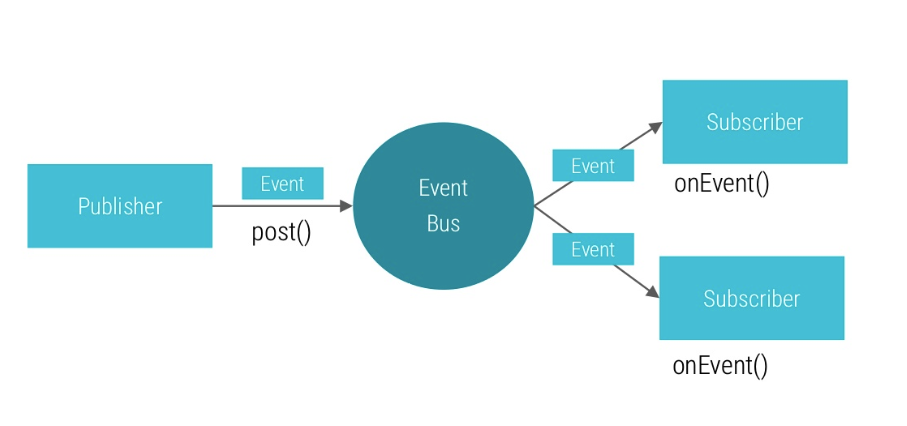EventBus项目中观察者模式解析
概括:
观察者模式是Android一个非常常用的设计模式,它完美的将观察者和被观察的对象分离开,定义了对象间的一种一对多的依赖关系,以便一个对象的状态发生变化时,所有依赖于它的对象都得到通知并自动刷新。
EventBus介绍:
EventBus是Android下高效的发布/订阅事件总线机制。是基于JVM内部的数据传输系统,其核心对象为Event和EventHandler。作用是可以代替传统的Intent,Handler,Broadcast或接口函数在Fragment,Activity,Service,线程之间传递消息,优点是开销小,代码更优雅,以及将发送者和接收者解耦。
Event是个著名开源项目,它的源码github地址为:
EventBus 3.0.0的发布和订阅事件的架构如下:

EvenBus 3步骤使用流程
1.定义事件
public static class MessageEvent { /* Additional fields if needed */ }
2.准备订阅的过程
声明和注释自己的订阅方法,可选指定的线程模式
@Subscribe(threadMode = ThreadMode.MAIN)
public void onMessageEvent(MessageEvent event) {/* Do something */};
注册或者取消订阅者,
@Override
public void onStart() {
super.onStart();
EventBus.getDefault().register(this);
}
@Override
public void onStop() {
super.onStop();
EventBus.getDefault().unregister(this);
}
3.把发生的时间给传递到订阅者
EventBus.getDefault().post(new MessageEvent());
对EventBus源码中的观察者模式进行解析:
1事件订阅
public void register(Object subscriber) { Class<?> subscriberClass = subscriber.getClass(); List<SubscriberMethod> subscriberMethods = subscriberMethodFinder.findSubscriberMethods(subscriberClass); synchronized (this) { for (SubscriberMethod subscriberMethod : subscriberMethods) { subscribe(subscriber, subscriberMethod); } } }
2使用反射获取订阅信息:
private List<SubscriberMethod> findUsingInfo(Class<?> subscriberClass) { FindState findState = prepareFindState(); findState.initForSubscriber(subscriberClass); while (findState.clazz != null) { findState.subscriberInfo = getSubscriberInfo(findState); if (findState.subscriberInfo != null) { SubscriberMethod[] array = findState.subscriberInfo.getSubscriberMethods(); for (SubscriberMethod subscriberMethod : array) { if (findState.checkAdd(subscriberMethod.method, subscriberMethod.eventType)) { findState.subscriberMethods.add(subscriberMethod); } } } else { findUsingReflectionInSingleClass(findState); } findState.moveToSuperclass(); } return getMethodsAndRelease(findState); }
3使用EventBusAnnotationProcessor解析结果获取订阅信息
private List<SubscriberMethod> findUsingInfo(Class<?> subscriberClass) { FindState findState = prepareFindState(); findState.initForSubscriber(subscriberClass); while (findState.clazz != null) { findState.subscriberInfo = getSubscriberInfo(findState); if (findState.subscriberInfo != null) { SubscriberMethod[] array = findState.subscriberInfo.getSubscriberMethods(); for (SubscriberMethod subscriberMethod : array) { if (findState.checkAdd(subscriberMethod.method, subscriberMethod.eventType)) { findState.subscriberMethods.add(subscriberMethod); } } } else { findUsingReflectionInSingleClass(findState); } findState.moveToSuperclass(); } return getMethodsAndRelease(findState); }
4绑定订阅对象和方法
private void subscribe(Object subscriber, SubscriberMethod subscriberMethod) { Class<?> eventType = subscriberMethod.eventType; Subscription newSubscription = new Subscription(subscriber, subscriberMethod); CopyOnWriteArrayList<Subscription> subscriptions = subscriptionsByEventType.get(eventType); if (subscriptions == null) { subscriptions = new CopyOnWriteArrayList<>(); subscriptionsByEventType.put(eventType, subscriptions); } else { if (subscriptions.contains(newSubscription)) { throw new EventBusException("Subscriber " + subscriber.getClass() + " already registered to event " + eventType); } } int size = subscriptions.size(); for (int i = 0; i <= size; i++) { if (i == size || subscriberMethod.priority > subscriptions.get(i).subscriberMethod.priority) { subscriptions.add(i, newSubscription); break; } } List<Class<?>> subscribedEvents = typesBySubscriber.get(subscriber); if (subscribedEvents == null) { subscribedEvents = new ArrayList<>(); typesBySubscriber.put(subscriber, subscribedEvents); } subscribedEvents.add(eventType); if (subscriberMethod.sticky) { if (eventInheritance) { // Existing sticky events of all subclasses of eventType have to be considered. // Note: Iterating over all events may be inefficient with lots of sticky events, // thus data structure should be changed to allow a more efficient lookup // (e.g. an additional map storing sub classes of super classes: Class -> List<Class>). Set<Map.Entry<Class<?>, Object>> entries = stickyEvents.entrySet(); for (Map.Entry<Class<?>, Object> entry : entries) { Class<?> candidateEventType = entry.getKey(); if (eventType.isAssignableFrom(candidateEventType)) { Object stickyEvent = entry.getValue(); checkPostStickyEventToSubscription(newSubscription, stickyEvent); } } } else { Object stickyEvent = stickyEvents.get(eventType); checkPostStickyEventToSubscription(newSubscription, stickyEvent); } } }
5解除订阅
/** Unregisters the given subscriber from all event classes. */ public synchronized void unregister(Object subscriber) { List<Class<?>> subscribedTypes = typesBySubscriber.get(subscriber); if (subscribedTypes != null) { for (Class<?> eventType : subscribedTypes) { unsubscribeByEventType(subscriber, eventType); } typesBySubscriber.remove(subscriber); } else { logger.log(Level.WARNING, "Subscriber to unregister was not registered before: " + subscriber.getClass()); } }
6事件发布相关
public void post(Object event) { PostingThreadState postingState = currentPostingThreadState.get(); List<Object> eventQueue = postingState.eventQueue; eventQueue.add(event); if (!postingState.isPosting) { postingState.isMainThread = isMainThread(); postingState.isPosting = true; if (postingState.canceled) { throw new EventBusException("Internal error. Abort state was not reset"); } try { while (!eventQueue.isEmpty()) { postSingleEvent(eventQueue.remove(0), postingState); } } finally { postingState.isPosting = false; postingState.isMainThread = false; } } }
//发布sticky event
public void postSticky(Object event) { synchronized (stickyEvents) { stickyEvents.put(event.getClass(), event); } // Should be posted after it is putted, in case the subscriber wants to remove immediately post(event); }
观察者模式作用:
它的最大作用是解耦,修改一个地方的一句代码,往往会牵涉到其他地方也需要跟着一起做修改。这就是一种耦合。牵一发而动全身,这样会给程序埋下很大的安全隐患,特别是在功能强大起来,代码量增加以后。而观察者模式可以很大程序的解决这样的耦合问题,让代码简约、耦合度低。
在项目中作用:
最大作用是解耦事件订阅和发布者,将事件的订阅和发布很好地解耦,使代码更优雅,逻辑更清晰。
避免了复杂且易导致错误的依赖和生命周期问题,该项目已经在100,000,000+个应用上得到了证明



